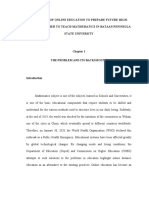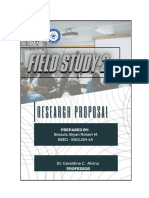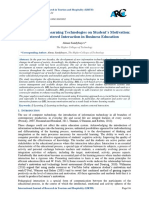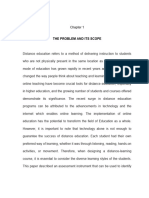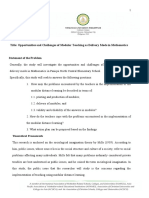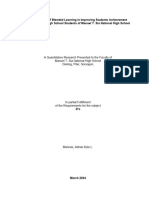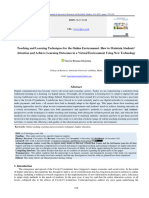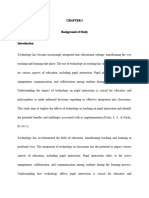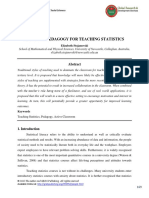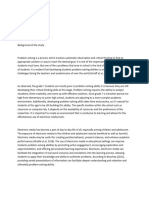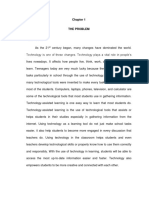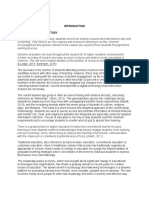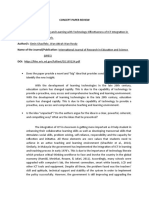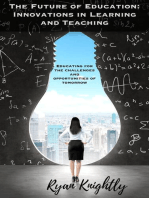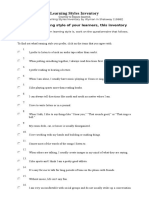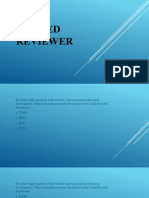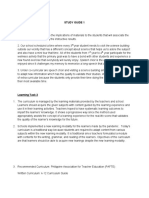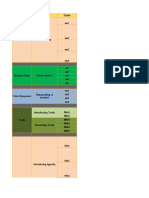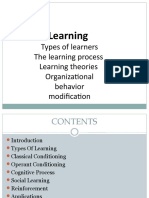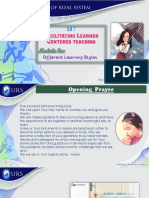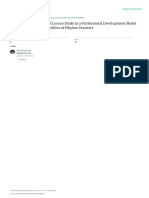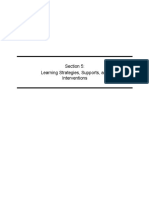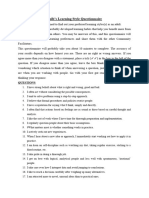2 +EL+2623+Final+Javorcik
2 +EL+2623+Final+Javorcik
Uploaded by
Trixia Nicole B. SalvaCopyright:
Available Formats
2 +EL+2623+Final+Javorcik
2 +EL+2623+Final+Javorcik
Uploaded by
Trixia Nicole B. SalvaOriginal Title
Copyright
Available Formats
Share this document
Did you find this document useful?
Is this content inappropriate?
Copyright:
Available Formats
2 +EL+2623+Final+Javorcik
2 +EL+2623+Final+Javorcik
Uploaded by
Trixia Nicole B. SalvaCopyright:
Available Formats
Microlearning in the Education of Future Teachers: Monitoring and
Evaluating Students’ Activity in a Microlearning Course
Tomas Javorcik, Katerina Kostolanyova and Tatiana Havlaskova
Department of Information and Communication Technologies, Faculty of Education,
University of Ostrava, Czech Republic
tomas.javorcik@osu.cz
katerina.kostolanyova@osu.cz
tatiana.havlaskova@osu.cz
Abstract: Microlearning has become a promising modern and effective approach to the education of various
groups in recent years. In order to be able to further develop microlearning and consider student individualities
it is necessary to map their passage through a course in detail. The article presents the conclusions of a research
carried out at the Faculty of Education of the University of Ostrava. The aim of the research was to find out
whether there are differences in approaches of studying a microlearning course. A microlearning course focused
on teaching future teachers was created for the purposes of the research. The aim of the course was to present
to students the possibilities of using digital technologies in the educational process. The research was conducted
in the winter semester of the academic year 2021/2022. A total of 378 students participated in the study in the
first phase (precourse survey) and subsequently 156 students in the second phase (analysis of course
participants' behavior). Student activity was monitored during the study through learning analytics tools. Time
of study, the number of realized events, the number of registrations, etc. were recorded for each student with
these tools. The obtained data were analyzed using cluster analysis. Total of six different approaches that led to
the successful completion of a microlearning course were described based on this analysis. The approaches can
be used to describe a successful strategy to go through a microlearning course including the extreme ones. An
interesting fact is that the choice of strategy is not influenced by the student's gender. The only parameter where
significant differences were found was the number of days to finish the microlearning course. In addition, the
article describes the behavior of students in the course, the types of learning materials, devices from which they
logged in the course and list of the most used course components. This part of the data was recorded via
heatmaps. A detailed description of students' study strategies within microlearning courses can improve the
effectiveness of microlearning also in connection with the personalized passage and thus improve the quality
and efficiency of the educational process of future teachers.
Keywords: Online learning, Microlearning, e-Learning, Learning analytics, Future teachers
1. Introduction
Active teachers, pupils, and students notice new trends that can have a positive impact on the education
process. It can be assumed that those involved in education want to teach and be taught using modern
approaches that reflect the latest trends, including teaching aids and technology. When integrating modern
educational resources, such as digital technology, into the education process, they are often rejected by teachers
and parents, which may be caused by various factors (lack of information, bad experience, fear or prejudices
against digital technology, lack of support from the school). To change this attitude and to make the teacher
want to use it in their courses (or transform them – or part of them – into e-learning courses), digital technology
needs to be used in a way that makes the education process more effective.
One way to catch the attention of those who support the integration of digital technology into the education
process as well as those who are against it is to further develop e-learning and adapt it to meet the demands of
today’s world. This does not necessarily mean finding a new method or education model that will result in better
knowledge and retention and skill acquisition, but rather trying to look for more effective teaching methods,
e.g., shortening the time required to learn new information, improving the activation and motivation of
students, as well as their attention span. Those are the key factors in today’s world.
In today’s technology-centered world where the majority of children and adults check notifications on their
smartphones every 30 minutes (Gausby, 2015), keeping students’ attention is a difficult task. According to
ISSN 1479-4403 13 ©The Authors
Reference this paper: Javorcik, T., Kostolanyova, K., and Havlaskova, T., 2023 Microlearning in the Education of Future
Teachers: Monitoring and Evaluating Students’ Activity in a Microlearning Course, The Electronic Journal of e-Learning, 21(1),
pp 13-25, available online at www.ejel.org
The Electronic Journal of e-Learning Volume 21 Issue 1 2023
Sternberg R. J. and Sternberg K. (2011), it is the attention that has a direct impact on long-term memory,
improving students’ knowledge retention and building links between new information and their existing
knowledge base. According to Microsoft Research (Gausby, 2015), one of the biggest factors that impacts the
ability to concentrate is technological development, which, since 2000, has led to a decreased attention span
(from 12 to 8.25 on average) in the age group of 18 – 55+. Research conducted by Bunce, Flens and Neiles (2010)
shows that students do not pay attention for 10-20 minutes during a lecture. This time is spread out during the
entire lecture, alternating between periods of paying and not paying attention (those cycles become shorter and
shorter as the lecture progresses). This study also suggests that students are more focused if a teacher uses
nontraditional methods, such as demonstration or groupwork. This result confirms well-established findings that
students are more engaged and attentive when they are doing something other than listening to the teacher
lecture. The same applies to online lectures that are often conducted through video conferencing platforms.
Regardless of the duration of a lecture, the engagement time has been determined to be 6 minutes at most
(Lagerstrom, Johanes, and Ponsukcharoen, 2015). Engagement time can be improved by implementing
interactive elements (questions, quizzes, etc.). Geri, Winer and Zaks (2017) argue that the average engagement
time can be increased by more than 20 %. The aforementioned studies show that students would prefer the
education content to be divided into small segments, which they could go through at their own pace. They would
also prefer interactive elements such as questions, quizzes, fill in blank questions, etc. This concept is used by
the following two models: Programmed Instruction Educational Model (Molenda, 2008) and Mastery Learning
(Joyce, Weil and Calhoun, 2017). Both models are based on the idea that the student manages their own
learning, which is then examined by a test. If unsuccessful, the student can repeat the unit and retake the test.
A decrease in attention span may be caused partly by today’s stressful world, which also affects education.
Technology forces us to multitask, i.e., to divide our attention between learning and our smartphone, which is
online all the time. Speed is important also in education, for a variety of reasons. People do not want to spend
a lot of time studying. They want to study in an effective manner (at their own pace, if possible), anytime and
anywhere. Because of the COVID-19 pandemic, it can be assumed that online learning will become much more
popular in the future. Multiple studies on online learning during the pandemic have already been published
(Mulla et al., 2020; Naddeo, Califano and Fiorillo, 2021). Today, quickly finding the information one is looking for
appears to be more popular than studying a comprehensive course, in which students encounter information
they already know from start to finish (Miller, 2019). The same is true of the professional world where companies
do not want to spend much time educating and training their employees – they would prefer it if they educated
themselves on-the-go, and were able to adapt to market changes and customer needs (Martins, Zerbini and
Medina, 2019).
When discussing students’ requirements on the structure and quality of the education process, one must not
forget the teachers. According to the survey conducted by the British Department of Education (Walker, Worth
and Den, 2019), teachers’ working hours have not been reduced (they still work approximately 1,700 hours a
year), despite the implementation of educational technology. When combined with the average class size (21
pupils in primary school and 23 pupils in secondary school) and curriculum size, teachers’ workload is too high.
Regarding innovating the education process, one needs to consider teachers’ workload and therefore all the
proposed changes should be aimed at making the education process as time efficient as possible.
Current trends in using digital technology for educational purposes, expectations of students, teachers’
workload, and the demands of today’s world have encouraged the authors to explore the use of digital
technology in education that would reflect the current trends. In their research, the authors focused on e-
learning, with which they have a wealth of experience as it is used at their workplace, both in formal and
nonformal education. The authors’ the research was aimed at the courses available in the Moodle Learning
Management System (Moodle LMS), which, as the authors have discovered, students do not study continuously
but rather all at once at the end of the semester/course (Polasek and Javorcik, 2020). That is why the authors
set out to transform the courses, so they could be studied continuously, anytime and anywhere.
Microlearning appears to be a worthy successor to e-learning, which meets the demands of today’s world (it
needs to be available anytime and anywhere, not overwhelmed with information, be interactive, offer diverse
learning objects, allow students to study at their own pace, etc.). In their research, the authors focused on the
impact of microlearning in different variations on different target groups. The research should provide answers
to the following questions:
Q1: What is the level of students’ digital technology skills, especially considering they are studying to become
teachers?
www.ejel.org 14 ©The Authors
Tomas Javorcik, Katerina Kostolanyova and Tatiana Havlaskova
Q2: Can different approaches to studying a microlearning course be identified?
Q2.1: Are there significant differences between men and women in their approach to studying a microlearning
course?
Q3: Which parts of a microlearning course are most/least used by students?
The authors used two different research methods to answer the aforementioned questions. A questionnaire
survey, which is a quantitative research method, was used to determine the level of students’ digital technology
knowledge and skills (Lee, Jahnke and Austin, 2021), while learning analytics was used to record students’
behavior in a microlearning course (Song, 2018).
2. Types of Microlearning
From a global perspective, microlearning is not a new term. However, in the Czech educational system it is not
as common as mobile learning. According to Buchem and Hamelmann (2010), the rise of microlearning was
heavily influenced by technological and economic changes, which were so significant that they increased the
demand for new educational concepts and strategies that would be different than the ones used today. The
most significant is the fact that learning is no longer tied to a particular time and place as it can occur anytime,
anywhere, and during almost any activity.
Microlearning is a comprehensive approach to education based on using web content in activities that are short
in time (Singh, 2014). Giurgiu (2017) adds that that these short activities should be independent but should also
build on each other (which is essential as it allows the learner to put information into context). The authors often
refer to these short learning units as microlearning units (MLU) or short information units (SIU).
Microlearning is closely associated with the following concepts (Buchem and Hamelmann, 2010):
• MicroContent – defines the ideal duration and form
• Web 2.0 – MLUs can be created, aggregated, and used (repeatedly)
• Social software – an integral part of students’ lives; it makes it easier for them to communicate while
studying
• eLearning 2.0 – using Web 2.0 technology for educational purposes
• Personal Learning Environment – creating and using micro content in informal learning
• Informal learning – short MLUs can be integrated into everyday activities
• Work-based learning – using MLUs for employee education
From a theoretical perspective, microlearning was described by Hug (2005, 2012) and others (Lindner, 2007;
Mathy and Feldman, 2012; Souza and Amaral, 2014). Hug (2005, 2012) defines the following MicroLearning
characteristics:
• Time: relatively easy, short
• Content: small units
• Form: fragments, episodes
• Focus: separate, integrated activities, maintain attention
• Mediality: various media – printed, online multimedia
• Learning method: repetition, constructivism, connectivism, etc.
Bersin (2017) argues that microlearning has evolved from eLearning. If we are to accept this notion, we need to
compare microlearning and e-learning and define the differences between them. The main difference is in the
course layout and the duration of its individual parts, through which educational content is presented to
students.
www.ejel.org 15 ISSN 1479-4403
The Electronic Journal of e-Learning Volume 21 Issue 1 2023
Figure 1: Graphic comparison of eLearning and microlearning (Bersin, 2017)
The individual levels (Level 1, Level 2, etc.), as seen in the picture above, are represented by the so-called
microlearning units, which can be represented by any learning object (text, presentation, video, audio,
animation, infographics, etc.). According to literature (Buchem and Hamelmann, 2010; Lindner, 2006; Hug,
Lindner and Bruck, 2006), it takes 2 to 15 minutes to learn the content.
As far as the time and content scope is concerned, learning objects can be divided into Micro level, Meso level
and Macro level (Hug, 2005). The individual levels (including examples) are described in the following table.
Table 1: Relation of micro learning, meso learning and macro learning to different areas (Hug, 2005)
Example 1 Example 2 Example 3 Example 4 Example 5 Example 6
Linguistics Language Educational Course Classification Sociology
instruction content structure of
competencies
Micro Individual Words, Educational Educational Students’ or Individualized
level letters phrases, objects, objects teachers’ learning
sentences micro competencies
content
Meso Words, Situations, Sub-topics, Topics, Lecture Group
level combination of episodes content- lessons proposal instruction or
signs and limited topics organized
numbers, learning
sentences
Macro Texts, Socio- Topics, Courses, Proposing Generational
level conversation cultural subjects structure of learning plans learning,
specifics, educational social
complex plans learning
semantics
The term “microcontent” is inherently linked to microlearning (Souza and Torres, 2015). Even though it was
originally associated only with Web (Dizon and Tang, 2017; Clark and Paivio, 1991), Lindner (2007) describes
microcontent as “all kinds of micro-chunked digital content: very small texts, pictures and graphics, and
combinations thereof; links; short low-resolution audio or video clips”, and introduces the term “micromedia”
(stressing the use of different content mediality). There are also other forms of microcontent, such as podcasts
or microblogging (Lindner, 2007; Salomonsen, 2018).
www.ejel.org 16 ©The Authors
Tomas Javorcik, Katerina Kostolanyova and Tatiana Havlaskova
Many authors have written about microlearning (both directly and indirectly). They have focused on the
following topics:
• Nursing education (Bian et al., 2014)
• Medical training and health professions (Simons, Foerster, Bruck, Motiwalla and Jonker, 2015)
• Language training (Fang, 2018)
• Engineering topics (Zheng et al., 2019)
• Programming skills (Skalka and Drlik, 2019)
Research showed that microlearning helps improve students’ motivation, participation in instruction and
performance.
Jahnke et al. (2020) provide an extensive overview of microlearning research. This study also outlines how
microlearning will evolve in the future, particularly when used along with mobile learning. There are already 25
platforms that allow microlearning content to be mediated through mobile technology (e.g., EdX, Lynda.com or
Skillshare).
Recent psychology findings on memory, learning or capturing and maintaining students’ attention also prove
the effectiveness of microlearning. The so-called Miller’s magical number, which argues that the number of
objects an average human can hold in short-term memory is 7 ± 2 (Miller, 1956), can serve as an example. If we
consider the learning theory and Miller’s magical number, a short attention span when it comes to learning, the
need to revise information stored in short-term memory, their retention (in order to learn), and today’s fast-
paced world, microlearning appears to be the clear choice. Since they reflect the existing knowledge on attention
span, the learning process characteristics and memory stages, MicroLearning Units (MLU) may be an appropriate
alternative (Morris et al., 2005; Salomonsen, 2018; Schmidt, 2007; Wissman, Rawson and Pyc, 2012).
In general, a learner’s attention span corresponds to their age. If the attention span increases, it leads to so-
called information overload, i.e., isolated and unconnected knowledge which leads to not understanding the
presented curriculum (Skoda and Doulik, 2011).
3. Design of Microlearning Course
A microlearning course with the aforementioned characteristics was created to verify the authors’ assumptions
and answer the research questions. To maintain scientific objectivity, the authors selected the course
“Information Technology in Education”. The goal of this course is to show the students (future teachers) how to
use digital technology in education. The course is mandatory for all future teachers studying at the Pedagogical
faculty of the University of Ostrava. Hence, the course was taken by students with different digital technology
knowledge and skills, with the conditions being the same for everyone.
The microlearning course consisted of 5 chapters:
1. Working with text and creating worksheets
2. Working with images and graphics
3. Multimedia
4. Online tools and sharing
5. Mobile technology and applications
Each chapter was designed to show the students how beneficial digital technology can be if used properly and
with a specific educational purpose. The chapters included MLUs in the form of short text, videos, video tutorials
and other interactive elements. A H5P module (HTML5 Package) was used to create the interactive elements.
At the end of each chapter, the students were required to design and create a product that could be used in
instruction (according to their specialization). In doing so, the students put the newly acquired information to
good use. The Moodle LMS was chosen for course creation and administration.
4. Methods
Research occurred during one semester from September to December 2020. 378 teacher students from the
Pedagogical Faculty of the University of Ostrava participated in the research study. The students studied in
programs aimed at different subjects (Czech language, music, arts, computer science, mathematics, etc.). Before
the start of the semester, each participant received an email with course specifications (requirements,
assignment submission guidelines, etc.). The email also included information about research participation. The
www.ejel.org 17 ISSN 1479-4403
The Electronic Journal of e-Learning Volume 21 Issue 1 2023
students were then enrolled in the microlearning course. Those who did not agree to participate in the research
study were enrolled in the same course, but were not asked questions or monitored.
The research study was divided into two stages. In the first stage, after logging into the microlearning course,
the students filled out a precourse survey that consisted of 23 questions aimed at demographic information
(e.g., gender, grade, age, etc.), their specialization, attitude toward digital technology and its use in the
education process and subjective evaluation of their digital technology skills (e.g. text processing, working with
images, creation of video tutorials, tests or online courses). This part of the study was aimed at determining,
through self-assessment, the students’ existing digital technology knowledge and skills, particularly with respect
to their future role as teachers. The authors assume that the students are able to accurately assess their digital
literacy (Porat, Blau and Barak, 2018). Based on the survey data, the microlearning course was adapted to better
suit the students’ needs. Selected topics were expanded while others were simplified, to allow the students to
pay more attention to the chapters they needed to improve in. However, no chapter was left out.
The second stage was aimed at the participants’ behavior. Since the authors were interested in identifying
different approaches to tackling the microlearning course, the second stage included only those participants
who successfully completed the course – the research sample was selected using stratified sampling by gender
(N = 156 students). The goal of this stage was to determine the behavior of microlearning course participants
through web analytics. The results allowed the authors to identify different approaches of microlearning course
participants. The website analytics tool Smartlook was used to monitor the behavior of course participants
(https://www.smartlook.com/).
The following parameters were monitored:
• Learning days (time between the first and last login)
• Number of events (number of clicks, text written and other student input)
• Total number of visits
• Length of each visit
• Type of device (smartphone, tablet, desktop computer)
• Course components used by students
Cluster analysis was used to analyze the collected, aggregated and standardized data to determine groups of
students with similar behavior.
5. Data Analysis
The first stage of research – the precourse survey – was conducted in September 2020, before the start of the
semester. Of the total 469 students enrolled in the course Information Technology in Education, 378 participated
in the precourse survey (80.6 %).
Table 2: Pre-course survey – research sample
n Age
Female Male Avg. SD
262 (69.31 %) 116 (30.69 %) 23.71 7.661
378
In the first part of the questionnaire, the respondents were asked to assess their attitude toward digital
technology and their digital skills. The majority of respondents reported a positive attitude toward digital
technology, with the average score on a five-point scale (1-positive, 5-negative) being 𝑥̅ = 2.25 (𝑥̃ = 2). The
answers the students gave when asked to evaluate their own knowledge and skills on a five-point scale
(1-excellent knowledge, 5-lack of knowledge) prove that they have not yet mastered all the skills and knowledge
a teacher should possess. Based on their answers, the respondents believed they were the most skilled at text
processing, creating presentations, information seeking and email management. On the other hand, they were
less confident about their skills required to create educational animations and video tutorials or create and
manage websites and e-courses. Tables 3 and 4 provide a detailed summary.
www.ejel.org 18 ©The Authors
Tomas Javorcik, Katerina Kostolanyova and Tatiana Havlaskova
Table 3: Student self-assessment of their digital skills – basic use of digital technology
Basic use of Absolute frequency Relative frequency [%]
digital ̅
𝒙 ̃
𝒙
technology 1 2 3 4 5 1 2 3 4 5
Text
1.992 2 102 192 71 11 2 26.98 50.79 18.78 2.91 0.53
processing
Data
2.791 3 35 113 146 64 20 9.26 29.89 38.62 16.93 5.29
processing
Use of images 2.280 2 78 166 90 38 6 20.63 43.91 23.81 10.05 1.59
Use of
2.526 2 67 129 109 62 11 17.72 34.13 28.84 16.40 2.91
photography
Sound
recording and 3.368 3 22 56 120 121 39 5.82 14.81 31.74 32.01 15.61
editing
Creating
1.915 2 138 163 57 11 9 36.51 43.12 15.08 2.91 2.38
presentations
Creating
3.566 4 11 61 111 93 102 2.91 16.14 29.37 24.60 26.98
animations
Creating video
3.791 4 16 38 89 101 134 4.23 10.05 23.54 26.72 35.45
tutorials
Use of
applications or
educational 2.780 3 45 118 125 55 35 11.90 31.22 33.07 14.55 9.26
purposes
Table 4: Student self-assessment of their digital skills – online environment
Online Absolute frequency Relative frequency [%]
̅
𝒙 ̃
𝒙
environment 1 2 3 4 5 1 2 3 4 5
Information
1.479 1 231 127 11 4 5 61.11 33.60 2.91 1.06 1.32
seeking
1.563 1 215 132 17 9 5 56.88 34.92 4.49 2.38 1.32
management
Use of cloud
2.757 3 50 117 118 61 32 13.23 30.95 31.22 16.14 8.47
services
Creating online
3.061 3 36 97 107 84 54 9.52 25.66 28.31 22.22 14.29
forms
Creating online
2.976 3 41 106 106 71 54 10.85 28.04 28.04 18.78 14.29
documents
Creating online
3.270 3 25 84 109 84 76 6.61 22.22 28.84 22.22 20.11
tests
Creating
3.746 4 18 37 100 91 132 4.76 9.79 26.46 24.08 34.92
websites
Creating e-
3.921 4 9 31 90 99 149 2.38 8.20 23.81 26.19 39.42
courses
The majority of respondents (n=318; 84.13 %) reported they intended to improve the aforementioned skills. The
remaining respondents either stated that they were satisfied with their level of skills and knowledge (n=23;
6.08 %) or that they had yet to discover their own potential (n=37; 9.79 %).
The second part of the questionnaire was aimed at learning the students’ opinions on the integration of digital
technology into the education process. The participating future teachers have a positive attitude toward
integrating digital technology into instruction (𝑥̃ = 2; 1-positive attitude, 5-negative attitude).
The results show that future teachers intend to use digital technology in their classes – 342 respondents
(90.58 %) intend to use digital technology in their classes, with the majority of respondents reporting that they
are not stressed at all or only slightly stressed (n=238, 62.96 %) about using it. As far as teaching stages are
concerned, the students intend to use digital technology during the motivation (n=304) and application (n=242)
stages. 136 respondents selected the motivation stage as the only option out of the five presented (motivation,
exposition, retention, diagnostic and application) while 30 respondents selected all five options.
The majority of respondents would use digital technology to present the curriculum (n=331, 87.57 %); 126 of
them would use it exclusively for this purpose. The remaining respondents chose different combinations of the
www.ejel.org 19 ISSN 1479-4403
The Electronic Journal of e-Learning Volume 21 Issue 1 2023
available options (to present the curriculum, for modeling/simulation, testing, to record students’
grades/performance). 58 respondents chose all available options.
A closer look at the collected data shows that the students approached the microlearning course differently.
The average learning time was 59.15 days (time between the first login and the final assessment given by the
tutor). During this period, the actual time spent studying was also measured (i.e., the time the students were
logged into the course – which was 3.31 hours on average). During this period, the students performed 813.77
actions (events) in 56.99 logins on average. The average length of one login was 3.31 minutes. The standard
deviation values for monitored characteristics (Table 5) indicate large differences between students’ strategies
in terms of how they approach the course.
Table 5: Aggregate data acquired by recording student activity in the microlearning course
Number
Number Number Time per of
Learning of Time Number of events Length / Length / day logins
days events (hours) of logins per day login event (minutes) per day
Avg. 59.15 813.77 3.31 56.99 16.17 236.68 23.06 4.05 1.16
SD 30.14 902.78 2.76 36.36 15.19 204.40 52.17 3.07 1.00
Median 61.00 608.00 2.74 49.00 11.04 197.64 14.89 3.10 0.90
If one were to divide the research sample by gender, one would find further differences in approaching the
course. Due to the nature of the data, a Mann-Whitney U-test was used to determine statistically significant
differences in behavior in the microlearning course between male and female students. Of all the data recorded
by the web analytics tool, the only statistically significant difference was in the time spent studying (p-value
0.014), with men studying longer (more days) than women. Even though there were differences in other
monitored data, none of them were statistically significant. The results, including the calculated p-values, are
presented in Table 6.
Table 6: Behavior of students in the microlearning course by gender
Avg. women Avg. men
Monitored data (N=102) (N=54) P-value
Learning days 53.422 68.87 0,0135
Number of days 709.71 1008.4 0.40868
Total learning time
(seconds) 11.140 13.408 0.997
Number of logins 53.842 62.889 0.52673
Number of events per
day 15.554 17.334 0.33165
Length/login (seconds) 255.88 200.77 0.22155
Length/event (seconds) 22.499 24.123 0.39916
Time per day (seconds) 253.89 222.44 0.1794
Number of logins per
day 1.1331 1.2167 0.60296
Cluster analysis was used to provide a more accurate picture of the collected data, allowing the authors to
identify common features across the research sample. Using cluster analysis (Euclidean distance in particular),
clusters with common features were identified (the results are presented in Table 7).
Table 7: Characteristics of identified clusters determined through Euclidean distance
Number Number Number
Learning of Number of events Length Length Time of logins
Cluster n days events Time of logins per day /login / event per day per day
1 18 63.17 1002.00 5.09 90.00 16.33 3.60 20.33 5.00 1.47
2 61 70.33 663.01 2.55 52.44 9.55 3.04 15.63 2.23 0.76
3 18 25.39 372.00 1.32 26.83 22.70 3.96 43.91 4.69 1.46
www.ejel.org 20 ©The Authors
Tomas Javorcik, Katerina Kostolanyova and Tatiana Havlaskova
Number Number Number
Learning of Number of events Length Length Time of logins
Cluster n days events Time of logins per day /login / event per day per day
4 12 108.08 1827.00 7.87 110.50 18.87 4.15 17.26 4.90 1.15
5 23 42.13 482.13 2.26 35.74 12.85 6.47 39.89 4.37 0.91
6 19 28.53 591.00 2.66 43.89 29.62 3.83 15.47 7.15 2.18
Using cluster analysis, the authors identified 6 groups of students (based on how they approached the course).
Cluster 1 students (n=18) logged into the course often and their time spent studying was above average. Their
number of logins per day was also above average. Cluster 2 (n=61) includes the largest number of students. This
group of students spent the shortest amount of time studying per day. Their other values were average. Cluster
3 is a perfect example of cramming. This group spent the shortest overall time studying; they tried to perform
as many actions (events) per day as possible. This group’s goal was to complete the course in the shortest time
possible. Cluster 4 students spent the most time studying, performed the most actions (events) and studied the
course the longest. It can be assumed that this group included students with low digital literacy and students
who did not find this type of learning appealing. Cluster 5 students approached the course in a similar way to
Cluster 3 students, the only difference being that they did not log into the course as many times a day, but tried
to accomplish as much as possible during one visit. Cluster 6 is another example of cramming. When compared
to Cluster 3, this group’s approach was even more extreme, with a higher total number of logins, time spent
studying and number of events per day. This group’s goal was to minimize the time spent studying.
The website analytics tool heatmap was used to determine which parts of the course the students used the most
often. It provided information about the number of clicks on the particular parts of chapters. The data on student
activity in the individual course chapters are presented in Table 8.
Table 8: Student activity in the individual chapters of the microlearning course
Type of device
No. of Computer / Smartphone /
No. of displays clicks laptop tablet
Introduction 769 651 726 43
Topic 1 1,836 1,196 1,806 30
Topic 2 1,185 876 1,168 17
Topic 3 634 392 618 16
Topic 4 891 493 878 13
Topic 5 1,173 550 1,134 39
The table shows that the most visited chapters were Topic 1 (Working with text and creating worksheets), Topic
2 (Working with images and graphics) and Topic 5 (Mobile technology and applications). Working with text and
creating worksheets chapter also had the most clicks. The individual chapters differed in the total number of
clicks, which was caused by the fact that the students did not always use all the available study materials. As far
as educational materials are concerned, the students preferred videos and video tutorials to text materials. The
amount of used educational materials in the chapter was influenced by its thematic focus. When working with
common apps (e.g., MS Word, MS PowerPoint or Google cloud tools), the students did not use many materials.
In these chapters, they chose educational materials aimed at using those tools for educational purposes. When
working with less common apps, however, the students used the majority of available materials, including
additional information and external links.
Heatmaps were also used to determine the type of device the students accessed the course from. The majority
of students accessed the course from a desktop computer/laptop. Only a minority of students accessed it from
a mobile device (a smartphone or a tablet).
6. Discussion
The presented results allow the authors to answer the aforementioned research questions. Those were:
Research question 1: What is the level of students’ digital technology skills, especially considering they are
studying to become teachers?
www.ejel.org 21 ISSN 1479-4403
The Electronic Journal of e-Learning Volume 21 Issue 1 2023
Conducted before the start of the microlearning course, the pre-course survey showed that the students were
confident about some of their skills (text processing, creating presentations, information seeking, and email
management) and less confident about others, which a future teacher should have (creating video tutorials or
creating online tests). The results prove that to make the education process more modern and effective, future
teachers need to constantly develop their knowledge and skills on the use of digital technology in education.
According to the authors, students’ input knowledge needs to be monitored constantly. When compared with
a similarly focused study on the digital literacy of elementary school students, the results are similar (despite
the significant age difference among respondents). The fact that university and elementary school students have
a similar level of digital literacy may be caused by the high (and ever-growing) digital literacy of young students.
The ITFitness survey results support this argument (Kucera and Jakab, 2020).
Research question 2: Can different approaches to studying a microlearning course be identified?
Data acquired through web analytics showed statistically significant deviations, which means there were
different approaches to studying the microlearning course, and with different results. If we focus on the
differences between men and women in how they approach the course, we will learn that the only statistically
significant difference was in the time spent studying, with men studying longer (more days) than women
(p=0.01). Data from previously published studies reveal several reasons why men take longer to complete the
course than women. Women tend to login into the Moodle LMS more often and can organize their online
learning more efficiently. On the other hand, men tend to find the Moodle LMS difficult to navigate (García-
Martín and García-Sánchez, 2017). Moreover, women are also more productive in an online environment than
men (Caspi, Chajut and Saporta, 2008). However, it needs to be said that their cultural background may also
have an impact on the differences (and their extent) between men and women (Li and Kirkup, 2007). Even
though it took men more days to complete the course, they did not spend more time doing so (p=0.997). They
only spread it out over more days.
Using cluster analysis, the authors identified 6 groups of students (based on how they approached the course).
There were students who used a cramming strategy, there were students who studied continuously and then
there were students who completed the course, but it took more effort and time. Since there are multiple ways
to successfully complete a microlearning course, there might be a connection between the student’s learning
style and their strategy in regard to working their way through the course. The course components (types of
educational materials) used by the student might be an important guide (Ocepek et al., 2013).
Research question 3: Which parts of a microlearning course are most/least used by students?
The website analytics tool heatmap was used to determine which chapters and their parts the students accessed
the most often and which had the most clicks. The most visited chapters were those aimed at working with text
and creating worksheets, working with images and graphics and mobile technology and applications. It is unclear
whether this activity was caused by students’ interest or the chapter’s difficulty level. The number of events
(clicks) corresponds to the number of used materials. Regarding chapters with a higher number of clicks, it can
be assumed that some students either kept coming back to the same educational materials or needed to go
through more materials to be able to complete the course. As far as particular parts of the individual chapters
are concerned, the heatmap data show that the students preferred the multimedia content (video, animations
and interactive elements). The fact that in e-learning students tend to prefer multimedia to text supports this
argument (Lam et al., 2014). Text materials were used sporadically, especially in chapters aimed at less
traditional tools that the students were not familiar with, and which required more studying (i.e., they needed
to consult more materials). The popularity of video, multimedia and other interactive elements is documented
in other published studies written by authors with different cultural backgrounds (Afacan Adanir et al. , 2020;
Muthuprasad et al., 2021).
The assumption that in e-learning and microlearning students mostly used mobile devices to access the course
content was not confirmed. The majority of students accessed the course from a desktop computer/laptop. Only
a minority of students accessed it from a mobile device (smartphone or tablet). The results of this study
contradict the results of other studies published both in the Czech Republic and other countries where the use
of mobile devices for educational purposes is more pronounced (Klimova, 2017, Muthuprasad et al., 2021).
Research could be made more accurate by using Eye-Tracking, which would allow the authors to monitor
students’ attitude toward individual materials and compar
e it with similarly focused studies (Conley, Earnshaw and McWatters, 2020; Copeland and Gedeon, 2014).
www.ejel.org 22 ©The Authors
Tomas Javorcik, Katerina Kostolanyova and Tatiana Havlaskova
7. Conclusion
Future teachers have different input knowledge and skills. Such education should aim to produce teachers with
identical input knowledge, which would allow them to use digital technology in an effective and useful way,
regardless of the subject.
One of the ways to achieve this goal is to incorporate microlearning into the education of future teachers. The
authors chose microlearning because its positive impact on learning has been described in recently published
studies, and the sheer volume of available materials that they wanted to include in the microlearning course.
The main goal of the study was to prove the students use different learning approaches and to identify the parts
of the course that are accessed more often than others. By analyzing data acquired through web analytics, the
authors identified 6 groups of students (based on how they approached the course). These groups differed in
terms of how long (how many days) it took them to complete the course, the number of events, total learning
time or the number of logins. Using these factors, the authors described each of the six groups.
It is interesting that aside from the time spent studying, there was no statistically significant difference in
behavior in the microlearning course between male and female students, with men studying longer (more days)
than women. The website analytics tool heatmap was used to determine which parts of the course the students
used the most often. As far as educational materials are concerned, the students preferred videos and video
tutorials to text materials. The amount of used educational materials in the chapter was influenced by its
thematic focus. When studying topics they were not familiar with, the students used the majority of available
materials. Students used mobile devices to access the course much less often than the authors expected.
The authors feel that findings of the study may contribute to incorporating microlearning into the education of
future teachers and to revealing appropriate strategies in navigating this type of course. Based on the presented
results, such courses can be adapted to those strategies and therefore make students’ learning more effective.
This study also opens new possibilities for further research.
With respect to the aforementioned findings, in future research the authors would like to focus on students’
learning styles and their impact on learning new information in microlearning courses. Designing a personalized
version of the microlearning course for every student based on their learning style (which would meet the
conditions of learning style variability according to the VARK test or Kolb’s experiential learning cycle) appears
to be an appropriate idea.
References
Afacan Adanır, G., Muhametjanova, G., Çelikbağ, M. A., Omuraliev, A. and İsmailova, R. (2020). Learners’ preferences for
online resources, activities, and communication tools: A comparative study of Turkey and Kyrgyzstan. E-Learning and
Digital Media, 17(2), pp. 148-166. https://doi.org/10.1177/2042753019899713
Bersin, J. (2017). The disruption of digital learning: Ten things we have learned. Retrieved from
https://joshbersin.com/2017/03/the-disruption-of-digital-learning-ten-things-we-have-learned/. Accessed November
6, 2021
Bian, H., Wu, J., Yang, Z., Liu, T. and Bian, Y. (2014). Application of micro-learning in physiology teaching for adult nursing
specialty students. Journal of Qiqihar Medical College, 26(21), 3219-3220.
Buchem, I. and Hamelmann, H. (2010). Microlearning: a strategy for ongoing professional development. ELearning Papers,
(21), pp. 1-14.
Bunce, D. M., Flens, E. A. and Neiles, K. Y. (2010). How long can students pay attention in class? A study of student
attention decline using clickers. Journal of Chemical Education, 87(12), pp. 1438-1443.
https://doi.org/10.1021/ed100409p
Caspi, A., Chajut, E. and Saporta, K. (2008). Participation in class and in online discussions: Gender differences, 50(3), pp.
718-724. https://doi.org/10.1016/j.compedu.2006.08.003
Clark, J. M. and Paivio, A. (1991). Dual coding theory and education. Educational Psychology Review, 3(3), pp. 149-210.
Conley, Q., Earnshaw, Y. and McWatters, G. (2020). Examining course layouts in blackboard: Using Eye-Tracking to evaluate
usability in a learning management system. International Journal of Human–Computer Interaction, 36(4), pp. 373-
385. https://doi.org/10.1080/10447318.2019.1644841
Copeland, L. and Gedeon, T. (2014). What are you reading most: Attention in eLearning. Procedia Computer Science, 39,
pp. 67-74. https://doi.org/10.1016/j.procs.2014.11.011
Dizon, G. and Tang, D. (2017). Comparing the efficacy of digital flashcards versus paper flashcards to improve receptive and
productive L2 vocabulary. The EuroCALL Review, 25(1), pp. 3-15. https://doi.org/10.4995/eurocall.2017.6964
Fang, Q. (2018). A study of college english teaching mode in the context of micro-learning. Proceedings of the 2018
International Conference on Management and Education, Humanities and Social Sciences (MEHSS 2018).
https://doi.org/10.2991/mehss-18.2018.50
www.ejel.org 23 ISSN 1479-4403
The Electronic Journal of e-Learning Volume 21 Issue 1 2023
García-Martín, J. and García-Sánchez, J. -N. (2017). Pre-service teachers' perceptions of the competence dimensions of
digital literacy and of psychological and educational measures, Computers & Education, 107, pp. 54-67.
https://doi.org/10.1016/j.compedu.2016.12.010
Gausby, A. (Ed.). (2015). Attention spans. Retrieved from http://pausethinkconsider.com/wp-
content/uploads/2016/09/microsoft-attention-spans-research-report.pdf. Accessed November 15, 2021
Geri, N., Winer, A. and Zaks, B. (2017). Challenging the six-minute myth of online video lectures: Can interactivity expand
the attention span of learners? Online Journal of Applied Knowledge Management, 5(1), pp. 101-111.
https://doi.org/10.36965/OJAKM.2017.5(1)101-111
Giurgiu, L. (2017). Microlearning an evolving elearning trend. Scientific Bulletin, 22(1), pp. 18-23.
https://doi.org/10.1515/bsaft-2017-0003
Hug, T. (2012). Microlearning. Encyclopedia of the Sciences of Learning, pp. 2268-2271. https://doi.org/10.1007/978-1-
4419-1428-6_1583
Hug, T. (2005). Micro Learning and Narration. Exploring possibilities of utilization of narrations and storytelling for the
designing of “micro units” and didactical micro-learning arrangements. In Online proceedings of the International
Conference „Media in Transition 4: The Work of Stories", (pp. 13). Cambridge: MIT. http://hug-
web.at/drupal/sites/default/files/2005_Microlearning-and-Narration_Hug.pdf. Accessed November 15, 2021
Hug, T., Lindner, M. and Bruck, P.A. (2006). Microlearning: Emerging concepts, practices and technologies after e-Learning.
Innsbruck university press.
Jahnke, I., Lee, Y. -M., Pham, M., He, H. and Austin, L. (2020). Unpacking the inherent design principles of mobile
microlearning. Technology, Knowledge and Learning, 25(3), pp. 585-619. https://doi.org/10.1007/s10758-019-09413-
w
Joyce, B. R., Weil, M. and Calhoun, E. (2017). Models of teaching. Pearson.
Klimova, B. (2017). Students´ preferences for learning materials in technology-enhanced higher education. New Trends and
Issues Proceedings on Humanities and Social Sciences, 2(1), pp. 20-28. https://doi.org/10.18844/prosoc.v2i11.1900
Kucera, P. and Jakab, F. (2020). IT Fitness test 2020. Retrieved from https://itas.sk/wp-content/uploads/2020/12/IT-
Fitness-Zaverecna-Sprava-2020-%E2%80%93-A4-1.pdf. Accessed November 11, 2021
Lagerstrom, L., Johanes, P. and Ponsukcharoen, U. (2015). The myth of the six-minute rule: Student Engagement with
Online Videos. In 2015 ASEE Annual Conference and Exposition Proceedings (pp. 26.1558.1-26.1558.17). ASEE
Conferences. https://doi.org/10.18260/p.24895
Lam, P., McNaught, C., Lee, J. and Chan, M. (2014). Disciplinary difference in students' use of technology, experience in
using eLearning strategies and perceptions towards eLearning. Computers & Education, 73, pp. 111-120.
https://doi.org/10.1016/j.compedu.2013.12.015
Lee, Y. -M., Jahnke, I. and Austin, L. (2021). Mobile microlearning design and effects on learning efficacy and learner
experience. Educational Technology Research and Development, 69(2), pp. 885-915. https://doi.org/10.1007/s11423-
020-09931-w
Li, N. and Kirkup, G. (2007). Gender and cultural differences in internet use: A study of China and the UK. Computers &
Education, 48(2), pp. 301-317. https://doi.org/10.1016/j.compedu.2005.01.007
Lindner, M. (2006). Use these tools, your mind will follow. Learning in immersive micromedia & microknowledge
environments. In D. Whitelock and S. Wheele (Eds.), The next generation. Research Proceedings of the 13th
Association for Learning Technology Conference (ALT-C 2006) (pp. 41-49). The Association for Learning Technolegy.
Lindner, M. (2007). What is microlearning? In M. Lindner and P. A. Bruck (Eds.), Micromedia and Corporate Learning (pp.
52-62). Innsbruck university press.
Martins, L. B., Zerbini, T. and Medina, F. J. (2019). Impact of online training on behavioral transfer and job performance in a
large organization. Revista de Psicología del Trabajo y de las Organizaciones, 35(1), pp. 27-37.
https://doi.org/10.5093/jwop2019a4
Mathy, F. and Feldman, J. (2012). What’s magic about magic numbers? Chunking and data compression in short-term
memory. Cognition, 122(3), pp. 346-362. https://doi.org/10.1016/j.cognition.2011.11.003
Miller, G. A. (1956). The magical number seven, plus or minus two: Some limits on our capacity for processing
information. Psychological Review, 63(2), pp. 81-97. https://doi.org/10.1037/h0043158
Miller, T. (2019). Curriculum reduction, cognitive load and understanding of core principles. Meditari Accountancy
Research, 28(1), pp. 1-25. https://doi.org/10.1108/MEDAR-01-2019-0438
Molenda, M. (2008). The programmed instruction era: When effectiveness mattered. TechTrends, 52(2), pp. 52-58.
https://doi.org/10.1007/s11528-008-0136-y
Morris, P. E., Fritz, C. O., Jackson, L., Nichol, E. and Roberts, E. (2005). Strategies for learning proper names: expanding
retrieval practice, meaning and imagery. Applied Cognitive Psychology, 19(6), pp. 779-798.
https://doi.org/10.1002/acp.1115
Mulla, Z. D., Osland-Paton, V., Rodriguez, M. A., Vazquez, E. and Kupesic Plavsic, S. (2020). Novel coronavirus, novel faculty
development programs: rapid transition to eLearning during the pandemic. Journal of Perinatal Medicine, 48(5), pp.
446-449. https://doi.org/10.1515/jpm-2020-0197
Muthuprasad, T., Aiswarya, S., Aditya, K. S. and Jha, G. K. (2021). Students’ perception and preference for online education
in India during COVID -19 pandemic. Social Sciences & Humanities Open, 3(1).
https://doi.org/10.1016/j.ssaho.2020.100101
www.ejel.org 24 ©The Authors
Tomas Javorcik, Katerina Kostolanyova and Tatiana Havlaskova
Naddeo, A., Califano, R. and Fiorillo, I. (2021). Identifying factors that influenced wellbeing and learning effectiveness
during the sudden transition into eLearning due to the COVID-19 lockdown. Work, 68(1), pp. 45-67.
https://doi.org/10.3233/WOR-203358
Ocepek, U., Bosnić, Z., Nančovska Šerbec, I. and Rugelj, J. (2013). Exploring the relation between learning style models and
preferred multimedia types. Computers & Education, 69, pp. 343-355.
https://doi.org/10.1016/j.compedu.2013.07.029
OECD. (2019). Education at a Glance 2019 OECD Indicators. Van Haren Publishing.
Polasek, R. and Javorcik, T. (2020). Analysis of student behaviour in e-learning courses in relation to academic
performance. In Proceedings of the European Conference on e-Learning (ECEL) (pp. 428-437). Academic Conferences
and Publishing International Limited. https://doi.org/10.34190/EEL.20.060
Porat, E., Blau, I. and Barak, A. (2018). Measuring digital literacies: Junior high-school students' perceived competencies
versus actual performance, Computers & Education, 126, pp. 23-36. https://doi.org/10.1016/j.compedu.2018.06.030
Salomonsen, S. (2018). Microlearning: The modern strategy for the modern workplace. Retrieved from
http://businessdocbox.com/Human_Resources/122782016-The-modern-strategy-for-the-modern-workplace.html.
Accessed November 10, 2021
Schmidt, A. (2007). Microlearning and the knowledge maturing process: Towards conceptual foundations for work-
integrated microlearning support. In M. Lindner and P. A. Bruck (eds.), Micromedia and Corporate Learning-
Proceedings of the 3rd International Microlearning 2007, (pp. 99-105). Innsbruck University Press
Simons, L. P. A., Foerster, F., Bruck, P. A., Motiwalla, L. and Jonker, C. M. (2015). Microlearning mApp raises health
competence: hybrid service design. Health and Technology, 5(1), pp. 35-43. https://doi.org/10.1007/s12553-015-
0095-1
Singh, R. P. (2014). 17 Awesome resources on micro-learning. ELearning Industry. Retrieved from
https://elearningindustry.com/awesome-resources-on-micro-learning. Accessed November 6, 2021
Skalka, J. and Drlík, M. (2020). Educational model for improving programming skills based on conceptual microlearning
framework. The Challenges of the Digital Transformation in Education, pp. 923-934. https://doi.org/10.1007/978-3-
030-11932-4_85
Skoda, J. and Doulik, P. (2011). Psychodidaktika: metody efektivního a smysluplného učení a vyučování. Grada.
Song, D. (2018). Learning Analytics as an educational research approach. International Journal of Multiple Research
Approaches, 10(1), pp. 102-111. https://doi.org/10.29034/ijmra.v10n1a6
Souza, M. I. F. and Amaral, S. F. (2014). Educational microcontent for mobile learning virtual environments. Creative
Education, 5(9), pp. 672-681. https://doi.org/10.4236/ce.2014.59079
Souza, M. I. F. and Torres, T. Z. (2015). Method for educational microcontent production. International Journal of Science
and Research, 4(11), pp. 1472-1482.
Stanic, T. (2014). How to bring micro-learning into reality? Retrieved from https://elearningindustry.com/how-to-bring-
micro-learning-into-reality. Accessed November 11, 2021
Sternberg, R. J. and Sternberg, K. (2011). Cognitive psychology. Wadsworth Publishing Company.
Walker, M., Worth, J. and Den, V. Dept for education and employment. (2019). Teacher workload survey 2019 : Research
report. Department Of Education.
Wissman, K. T., Rawson, K. A. and Pyc, M. A. (2012). How and when do students use flashcards? Memory, 20(6), 568-579.
https://doi.org/10.1080/09658211.2012.687052
Zheng, R., Zhu, J., Zhang, M., Liu, R., Wu, Q. and Yang, L. (2019). A novel resource deployment approach to mobile
microlearning: From energy-saving perspective. Wireless Communications and Mobile Computing, 2019, pp. 1-15.
https://doi.org/10.1155/2019/7430860
www.ejel.org 25 ISSN 1479-4403
You might also like
- Personal and Business Transformation Assignment STU49009Document23 pagesPersonal and Business Transformation Assignment STU49009Vishi SinghNo ratings yet
- Research Proposal Innovative Methods in Teaching Araling PanlipunanDocument29 pagesResearch Proposal Innovative Methods in Teaching Araling PanlipunanVinia Clexane Cuyasen Duyapat100% (4)
- Effects The Effects of Modular Learning Towards StudentDocument20 pagesEffects The Effects of Modular Learning Towards StudentJay Ar100% (3)
- Research Proposal Innovative Methods in Teaching Araling PanlipunanDocument33 pagesResearch Proposal Innovative Methods in Teaching Araling PanlipunanVinia Clexane Cuyasen Duyapat100% (2)
- Review of Related Literature 1Document6 pagesReview of Related Literature 1Mariam MamalubaNo ratings yet
- Sample Research OutputDocument5 pagesSample Research OutputRobert UmandalNo ratings yet
- Chapters-1-5 7Document43 pagesChapters-1-5 7kryfp5hm9rNo ratings yet
- Rajabalee-Santally2021 Article LearnerSatisfactionEngagementADocument34 pagesRajabalee-Santally2021 Article LearnerSatisfactionEngagementAPhoenix LeeNo ratings yet
- Chapter 1 CompilationDocument8 pagesChapter 1 CompilationQueenie Rain WingcoNo ratings yet
- Untitled Document - Edited 1Document6 pagesUntitled Document - Edited 1Shaina DaquilNo ratings yet
- Malzoubi,+882 Author+Article 268 1 6 20211008Document12 pagesMalzoubi,+882 Author+Article 268 1 6 20211008Maria Genevieve F. RedullaNo ratings yet
- 5306 15094 1 PBDocument10 pages5306 15094 1 PBHarlene ArabiaNo ratings yet
- Research ProposalDocument8 pagesResearch ProposalBryan Robert Maleniza BrosulaNo ratings yet
- Research Edtech Group ADocument19 pagesResearch Edtech Group ACARAGA MERRY ANN G.No ratings yet
- 4287 17553 1 PBDocument12 pages4287 17553 1 PBJoseph NacionalesNo ratings yet
- Mercado, Aimee Korine - Chapter 1-3Document22 pagesMercado, Aimee Korine - Chapter 1-3Aimee KorineNo ratings yet
- Mark_hane-Research-filesDocument34 pagesMark_hane-Research-filesJohane AculanaNo ratings yet
- 2 PDFDocument9 pages2 PDFFadi JamalNo ratings yet
- 1043-Article Text-3757-1-10-20230618Document10 pages1043-Article Text-3757-1-10-20230618RaihanNo ratings yet
- Term PaperDocument10 pagesTerm PaperXeres Neca AgunatNo ratings yet
- Blended Learning in Computing Education: It 'S Here But Does It Work?Document22 pagesBlended Learning in Computing Education: It 'S Here But Does It Work?Rafsan SiddiquiNo ratings yet
- Thesis For Final DefendDocument75 pagesThesis For Final Defendvenqzcyss01No ratings yet
- Mark_hane-Research-files-2Document42 pagesMark_hane-Research-files-2Johane AculanaNo ratings yet
- ED626883Document6 pagesED626883Phuong Lien LaiNo ratings yet
- Propsectus-Opportunities and Challenges of Modular Teaching As Delivery Mode in MathematicsDocument12 pagesPropsectus-Opportunities and Challenges of Modular Teaching As Delivery Mode in MathematicsNoel LacambraNo ratings yet
- Literature ReviewDocument8 pagesLiterature Reviewapi-478576013No ratings yet
- ADRIAN2Document8 pagesADRIAN2ljteofilo5No ratings yet
- Teaching and Learning Techniques For The Online Environment. How To Maintain Students' Attention and Achieve Learning Outcomes in A Virtual Environment Using New TechnologyDocument13 pagesTeaching and Learning Techniques For The Online Environment. How To Maintain Students' Attention and Achieve Learning Outcomes in A Virtual Environment Using New Technologystardust.m002No ratings yet
- Technology An Essential Component of Academic PerfDocument9 pagesTechnology An Essential Component of Academic PerfCharisse GiducosNo ratings yet
- CHAPTER 2 RRL 1Document7 pagesCHAPTER 2 RRL 1Zoe IsabellaNo ratings yet
- Research 10Document12 pagesResearch 10Abdur DapitillaNo ratings yet
- Research Project: B.Ed. (1.5 Year)Document27 pagesResearch Project: B.Ed. (1.5 Year)Javeria RajputNo ratings yet
- Chapter II RRL, RS & SYNTHESISDocument9 pagesChapter II RRL, RS & SYNTHESISsarah jane villarNo ratings yet
- CHAPTER I-WPS OfficeDocument12 pagesCHAPTER I-WPS OfficeRasmia MutiaNo ratings yet
- Adjusted Pedagogy For Teaching StatisticsDocument9 pagesAdjusted Pedagogy For Teaching StatisticsGlobal Research and Development ServicesNo ratings yet
- Ej 1340877Document14 pagesEj 1340877Taju HussenNo ratings yet
- DAMONSONG GROUP - Chapter 123.Document13 pagesDAMONSONG GROUP - Chapter 123.MARITES M. CUYOSNo ratings yet
- Adetipe Peace MoronkejiDocument32 pagesAdetipe Peace Moronkejiopeyemipeter4realNo ratings yet
- Research Chapter 1 - 3 2019-03-21Document10 pagesResearch Chapter 1 - 3 2019-03-21ahmad sahminan0% (1)
- The Effect of Computer Mediated Conferencing and Computer Assisted Instruction On Student Learning OutcomesDocument22 pagesThe Effect of Computer Mediated Conferencing and Computer Assisted Instruction On Student Learning OutcomesYulia AstutiNo ratings yet
- CHAPTER 1-WPS OfficeDocument6 pagesCHAPTER 1-WPS OfficeHans SamillanoNo ratings yet
- Artikel 10Document11 pagesArtikel 10Livia Siti RhosyadaNo ratings yet
- Barriers in Online Learning and Students' Math PerformanceDocument36 pagesBarriers in Online Learning and Students' Math PerformanceJeclyn FilipinasNo ratings yet
- CHAPTER 2 Ni Boss ShekieDocument12 pagesCHAPTER 2 Ni Boss ShekieUnknown NameNo ratings yet
- Document (2) (1)Document8 pagesDocument (2) (1)nisagokce65No ratings yet
- Nikka Abenion - Task 4 - Drafting The Introduction, Rationale of The Study, and Theoretical FrameworkDocument9 pagesNikka Abenion - Task 4 - Drafting The Introduction, Rationale of The Study, and Theoretical FrameworkNikka Ybañez Abenion - RosalesNo ratings yet
- Impact of Technology On Students Engagement Among Grade 11 Students of Dalton AcademyDocument30 pagesImpact of Technology On Students Engagement Among Grade 11 Students of Dalton AcademydugayasleyNo ratings yet
- GR4 - Final Research PaperDocument16 pagesGR4 - Final Research PaperHerjan PaulNo ratings yet
- Use of ICT and Student Learning in Higher Education:: Challenges and ResponsesDocument19 pagesUse of ICT and Student Learning in Higher Education:: Challenges and ResponsesDayna DamianiNo ratings yet
- Chapter 1 ENGLISH 1Document13 pagesChapter 1 ENGLISH 1Eric John CalsangNo ratings yet
- Revised Ch1 3Document28 pagesRevised Ch1 3Ma WenNo ratings yet
- Efficacy of Learning Modules in CalculusDocument49 pagesEfficacy of Learning Modules in CalculusJenefer BendejoNo ratings yet
- Background of The StudyDocument6 pagesBackground of The StudyRex Emmanuel IntalNo ratings yet
- INTRODUCTIONNDocument3 pagesINTRODUCTIONNAlerie SalvadorNo ratings yet
- Concept Paper ReviewDocument14 pagesConcept Paper Reviewcyrel seloveresNo ratings yet
- Cavite State UniversityDocument13 pagesCavite State UniversityBEVERLY GAMAONo ratings yet
- Distribution and Collection of Modules: An Evaluative ResearchDocument19 pagesDistribution and Collection of Modules: An Evaluative ResearchJerame M ColanoNo ratings yet
- Learning Autonomy - Online and Distance LearningDocument14 pagesLearning Autonomy - Online and Distance LearningLiza ShurmaniNo ratings yet
- Ayeni ReserchDocument37 pagesAyeni Reserchbaloguntaiwosamuel658No ratings yet
- Literature Research - Cabalida-SantosDocument7 pagesLiterature Research - Cabalida-SantosJeralyn CABALIDANo ratings yet
- The Future of Education: Innovations in Learning and TeachingFrom EverandThe Future of Education: Innovations in Learning and TeachingNo ratings yet
- Learning Styles InventoryDocument5 pagesLearning Styles InventoryJoel SiosonNo ratings yet
- MLS 052 - Activity 2Document3 pagesMLS 052 - Activity 2penonia.abegailashleyNo ratings yet
- IntroductionDocument127 pagesIntroductiondiona macasaquitNo ratings yet
- Successfully Teaching Ethics For Effective Learning: Ronald - Sims@business - Wm.edu Ed - Felton@business - Wm.eduDocument19 pagesSuccessfully Teaching Ethics For Effective Learning: Ronald - Sims@business - Wm.edu Ed - Felton@business - Wm.edumadspeterNo ratings yet
- CU 4. Education Process NewDocument20 pagesCU 4. Education Process NewJinky Cortez KimNo ratings yet
- A Digital Signal Processing Laboratory With StyleDocument7 pagesA Digital Signal Processing Laboratory With StyleAlwin Neil A. CasañadaNo ratings yet
- Lesson 4 Individual DifferencesDocument5 pagesLesson 4 Individual DifferencesMicaella MateoNo ratings yet
- Final Coaching Prof Ed1Document285 pagesFinal Coaching Prof Ed1REDEN JAVILLONo ratings yet
- Concrete SequentialDocument2 pagesConcrete SequentialRemmuel SantiagoNo ratings yet
- Ultimate Homeschool PlannerDocument16 pagesUltimate Homeschool PlannerSilvana BocaNo ratings yet
- Study Guide 1 Learning Task 1Document19 pagesStudy Guide 1 Learning Task 1Andrenet OrlandaNo ratings yet
- Math Chat ScriptsDocument64 pagesMath Chat Scriptsbag packkerNo ratings yet
- Self ManagementDocument78 pagesSelf ManagementvianlimNo ratings yet
- LearningDocument26 pagesLearningparimalamNo ratings yet
- WHLP 1Document3 pagesWHLP 1Jerald Pelasor FloritaNo ratings yet
- Cornell Note-Taking: Effective Way To Activate Students' Autonomous LearningDocument13 pagesCornell Note-Taking: Effective Way To Activate Students' Autonomous LearningLani HartantiNo ratings yet
- TSNA Self Assessment ToolDocument20 pagesTSNA Self Assessment ToolMayet Alunsagay-Delos ReyesNo ratings yet
- Ed7 Module 8A Different Learning StylesDocument41 pagesEd7 Module 8A Different Learning StylesPedro ManatadNo ratings yet
- LESSONSTUDY5158 ArticleText 9563 1 10 20210505Document13 pagesLESSONSTUDY5158 ArticleText 9563 1 10 20210505Ike LeeNo ratings yet
- Learning AssessmentDocument13 pagesLearning AssessmentAnnarizza ArceoNo ratings yet
- Section 5: Learning Strategies, Supports, and InterventionsDocument19 pagesSection 5: Learning Strategies, Supports, and Interventionsjade tagabNo ratings yet
- Math Lesson Plan Rubric 9-19-13 1Document8 pagesMath Lesson Plan Rubric 9-19-13 1api-302935183No ratings yet
- PDSM YadanarDocument146 pagesPDSM YadanarHtetThinzarNo ratings yet
- NEW Edited Final SDO Pampanga Refined BE LCOP 8-4-2021Document293 pagesNEW Edited Final SDO Pampanga Refined BE LCOP 8-4-2021Rio Mark Cabrera100% (1)
- Field Study 1 (Episode3)Document9 pagesField Study 1 (Episode3)Ms.BaeNo ratings yet
- Classroom DynamicsDocument4 pagesClassroom DynamicsVannakPhon100% (1)
- Kolb's Learning StyleDocument5 pagesKolb's Learning StyleUdeshika RajapakshaNo ratings yet
- Characteristics of The LearnerDocument56 pagesCharacteristics of The LearnerBryan Nartatez Bautista100% (1)








